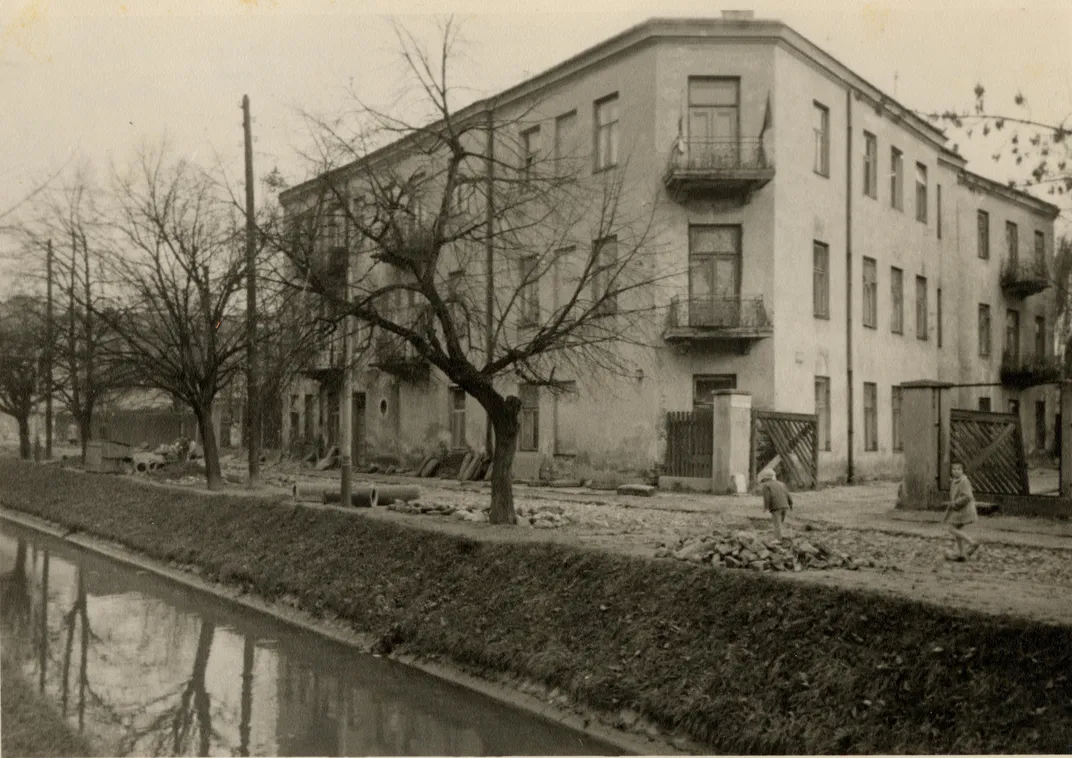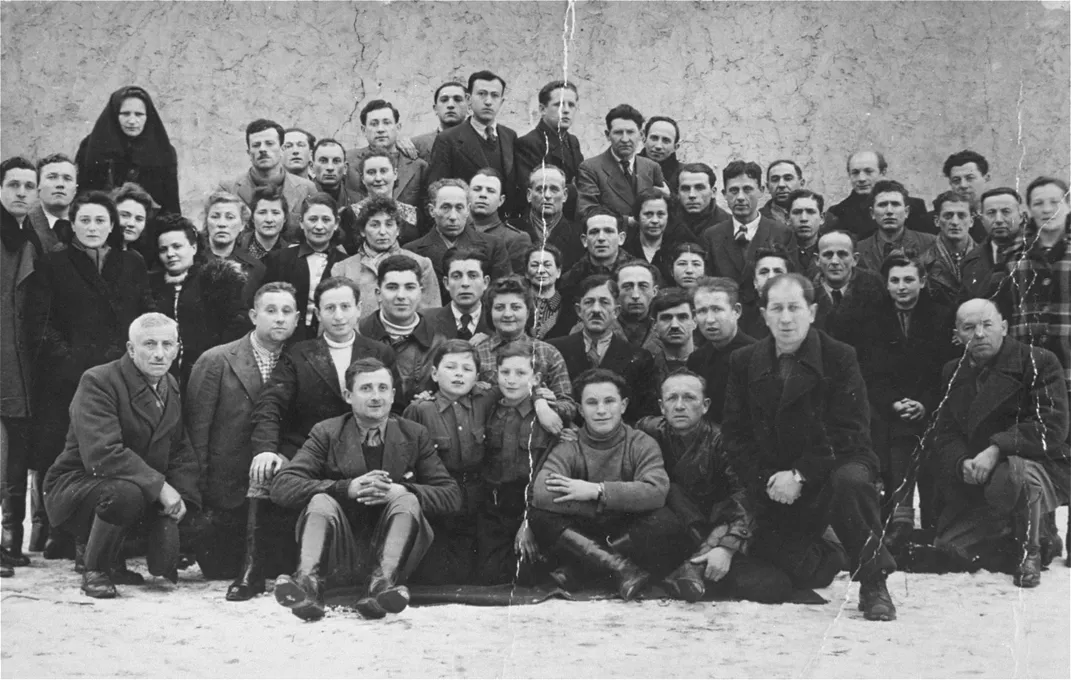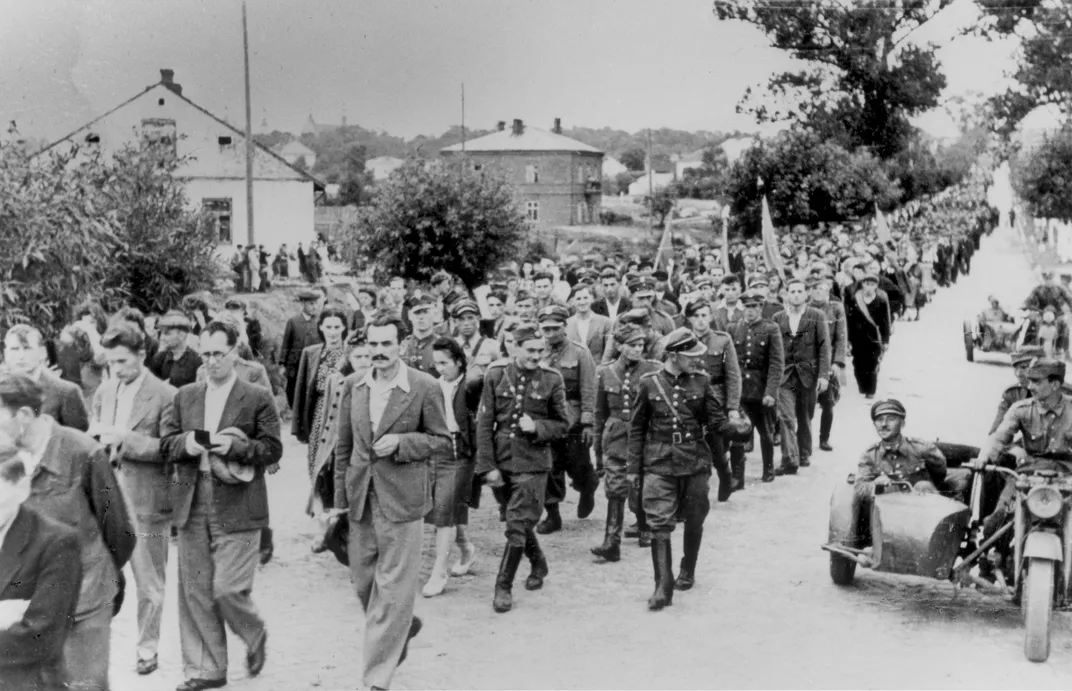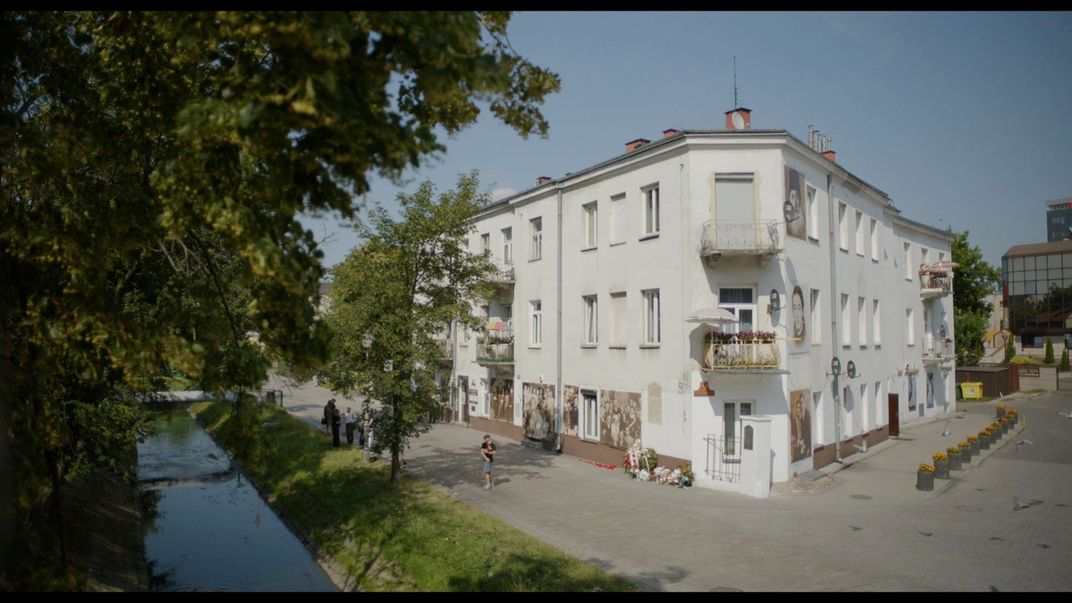Kielce: The Post-Holocaust Pogrom That Poland Is Still Fighting Over
After World War II, Jewish refugees found they could never return to their native land—a sentiment that some echo today
/https://tf-cmsv2-smithsonianmag-media.s3.amazonaws.com/filer/c9/87/c987c2c3-4658-43f4-acb3-ffc611416d59/69044.jpg)
The massacre started with a blood libel. That wouldn’t be unusual, except this wasn’t the Middle Ages or even Nazi Germany—it was 1946, a year after the end of World War II.
A few days earlier, an 8-year-old Polish boy named Henryk Błaszczyk had gone missing from his home in Kielce, Poland, a city of 50,000 in southeastern Poland. When Henryk reappeared two days later, he told his family he had been held by a man in a basement. As his father walked him to the police station to recount his story, the boy pointed at a man who was walking near the large corner building at 7 Planty Street.
He did it, Henryk said.
The building, which was owned by the Jewish Committee and housed many Jewish institutions, was home to up to 180 Jews. It did not have a basement. Most of the residents were refugees, having survived the horrors of the death camps that decimated more than 90 percent of the Polish Jewish population. After the war, they had returned to their homeland with the hope that they could leave the past behind them. They had no idea they were about to become the target of anti-Semitic aggression once again—this time from the Polish neighbors they lived alongside.
On the morning of July 4, a small group of state militia and local police approached the building to investigate the alleged kidnapping. As rumors of misdeeds spread, a version of the centuries-old “blood libel” that Jews were kidnapping Christian children for ritual sacrifice, a mob began to assemble. But it was the police and military who started the violence, recounts Polish historian Jan T. Gross in his 2006 book Fear: Anti-Semitism in Poland After Auschwitz. Though they were ostensibly there to protect civilians and keep the peace, officers instead opened fire and began dragging Jews into the courtyard, where the townspeople savagely attacked the Jewish residents.
That day, Jewish men and women were stoned, robbed, beaten with rifles, stabbed with bayonets, and hurled into a river that flowed nearby. Yet while other Kielce residents walked by, none did anything to stop it. It wasn’t until noon that another group of soldiers was sent in to break up the crowd and evacuate the wounded and dead. In the afternoon, a group of metal workers ran toward the building, armed with iron bars and other weapons. The residents of 7 Planty were relieved; they thought these men had come to help. Instead, the metal workers began brutally attacking and killing those still alive inside the building.
The violence went on for hours. As Miriam Guterman, one of the last remaining survivors of the pogrom, put it in the 2016 documentary film Bogdan’s Journey: “I couldn’t believe that these were humans.” (Guterman died in 2014.)

All told, 42 Jews were killed that day at 7 Planty and around the city, including a newborn baby and a woman who was six months pregnant. Another 40 were injured. Yet beyond the horror of those physical facts, the event would take on a larger historical significance. After the Holocaust, many Jews had dreamed of returning to their native lands. Kielce shattered that dream; for Jews, Poland could never again be home.
“[Kielce] really is a symbol of the exodus of Jewish survivors from Poland, and a symbol sometimes that there is no future in Poland for Jews,” says Joanna Sliwa, a historian with the Conference on Jewish Material Claims Against Germany who focuses on modern Polish Jewish history and the Holocaust. “That despite what Jews had endured during the Holocaust, and despite the fact that the local Polish population had observed all that, had witnessed all of that … Jews cannot feel safe in Poland.”
Sliwa points out that Kielce was not the first post-war pogrom against Jews in Poland; smaller outbursts of violence took place the previous year in Krakow and the town of Rzeszow.
In the years that followed, the Kielce pogrom—like so many atrocities committed or abetted by Poles during the war—became taboo. There were no memorials. When Bogdan Bialek, a Catholic Pole from Białystok, moved to Kielce in 1970, he sensed immediately that something was wrong. In Bogdan’s Journey, which was recently screened at an event at the Paley Center for Media in New York organized by the Claims Conference, Bialek remembers sensing a deep guilt or shame among residents when it came to talking about the pogrom. He calls this oppression of silence a “disease.”
Bialek became drawn to the abscess—what Jewish historian Michael Birnbaum referred to at the event as “the looming presence of absence”—that seemed to be haunting the town. Over the past 30 years, he made it his mission to bring this memory back to life and engage today’s residents of Kielce in dialogue through town meetings, memorials and conversations with survivors.
Unsurprisingly, he encountered pushback. The story of the Kielce massacre—which the film pieces together using the testimony of some of the last living victims and their descendants—is inconvenient. It challenges Poles. It opens old wounds. But for Bialek, bringing dialogue to this moment isn’t just about reopening old wounds—it is about lancing a boil. “Each of us has a tough moment in his past,” he says in the film, which was funded in part by the Claims Conference. “Either we were harmed, or we harmed someone. Until we name it, we drag the past behind us.”

Since the collapse of communism in 1989, Poland has gone through a soul-searching process that has progressed in bursts, with moments of clarity but also worrisome backsliding. Polish Jews have come out of the shadows, establishing new communities and reincorporating Jews back into the country’s fabric. In the mid-2000s, reports began to emerge documenting a curious trend: a “Jewish revival” of sorts sweeping Poland and beyond. Polish Jews reclaimed their roots; Polish-Jewish book publishers and museums sprung up; once-decimated Jewish quarters began to thrive again.
Part of that shift has been a reexamination of Poland’s history, Bialek said in an interview with Smithsonian.com. “We began with no understanding at all, with a kind of denial, and over time it’s been changing,” Bialek said in Polish, translated by Michał Jaskulski, one of the film’s directors. “These days it’s also easier for [Poles] to see from the perspective of the victims, which didn’t happen before. And we truly can notice how the pogrom strongly impacted Polish-Jewish relations.”
But there is still work to be done, he readily admits. While Poles today don’t deny that the pogrom actually happened, they do debate who deserves responsibility for the atrocity. Conspiracy theories ran rampant when Bialek first moved to Kielce, and he reports that they are still common today. In the film, co-director Larry Loewinger interviews several older residents who claim that the riot was instigated by Soviet intelligence, or even that Jews themselves staged a massacre by dragging bodies to the scene.
Unlike the better-known massacre at Jedwabne, when Poles living under Nazi control herded several hundred of their Jewish neighbors into a barn—and burned them alive—the tragedy in Kielce was borne out of post-war tensions. Poland was on the brink of civil war, its citizens were impoverished, and at the time many believed Jews were communists or spies. “You have to understand, Poland was a pretty miserable place in 1946,” says Loewinger. “It was poverty stricken. There were Jews floating around … There was a lot of anger all over.”
Yet there are clear parallels. Jedwabne happened in 1941, directly after the Nazi conquest of Poland; the accepted narrative is that the killing was carried out by Poles under pressure by Nazi Germans. In Kielce, the Polish people are equally “blameless.” Both of these narratives allow Poles to cling to a national mythology of victimhood and heroism. As Polish journalist and dissident Konstanty Gebert wrote in Moment, “Raised for generations with the (legitimate) belief that theirs was a martyred nation, many Poles found it increasingly hard to accept that their victimhood did not automatically grant them the moral high ground when it came to their behavior toward Jews during the Holocaust.”
Moreover, says Silwa, “Both of these events show how dangerous these conspiracy theories are, and how these myths about the so-called other, the blood libel, and … equating Jews with Communism, can turn into mob-like violence.”

In a 2016 television interview, Poland’s education minister Anna Zalewska appeared to deny Polish responsibility for any involvement in both of these historical events. When asked directly, “Who murdered Kielce’s Jews during the town pogrom?” she was unable to answer the question. She demurred, before finally answering: “Anti-Semites.” She did not admit that these anti-Semites were Poles. When controversy erupted, Zalewska received support from Foreign Minister Witold Wszczykowski, who said her comments had been “misunderstood.”
“It has to do with the Polish government, the effort to in a way rewrite history,” says Sliwa. “To put more emphasis on heroism and patriotism of the Polish nation during the war and after the war. It seems like it is an attempt to take hold over, to control, how the past is narrated.”
The concern that Poland is rewriting its history feels more relevant now than ever. Ever since the 2015 victory of the Law and Justice (Prawo i Sprawiedliwość) party, the right-wing populist party led by Jarosław Kaczyński, the government has pursued what is openly referred to as polityka historyczna, or “history policy.” Journalists and historians like Sliwa, however, call it “politicized history.” Of course, she adds, “there was discussion about this even before Law and Justice came to rule Poland. But now that taken over, it’s become so public and acceptable. And official, really official.”
You can see traces of this “history policy” in how the Kielce story has evolved over time. Despite the facts Gross and others have detailed, a 2004 report by the Institute of National Remembrance (IPN)—a state research institute that examines crimes committed by the Nazi and communist regimes and routinely minimizes Poland’s role in the Holocaust—concluded that the Kielce pogrom was the result of a “mishap.” This year, the Polish government backed legislation that would criminalize the use of the phrase “Polish death camps,” stating that the phrase wrongly implicated Poles as the orchestrators of Auschwitz and other Nazi death camps.
At the same time, Poland’s far right groups have grown emboldened. The largest demonstration of anti-immigrant and fascist attitudes coalesced in November of last year, on the country’s official Independence Day. The celebration, which has become an annual rallying point for Poland’s far-right groups, saw more than 60,000 demonstrators march through Warsaw calling for “White Europe.” Some threw red smoke bombs or carried banners with white supremacist symbols or phrases like “Clean blood.” Others chanted “Pure Poland, white Poland!” and “Refugees get out!”
The ruling party has long stoked fear of Muslim refugees, with Kaczyński saying in 2015 that migrants brought “dangerous diseases” including “all sorts of parasites and protozoa.” In 2017, Poland refused to take in refugees despite the European Union's threats to sue. Poland has also seen an upswing in racially motivated violence toward foreigners, with Muslims and Africans the most frequent targets of attacks. In 2016, Polish police investigated 1,631 hate crimes fueled by racism, anti-Semitism or xenophobia.

To Bialek, these attitudes are a scary echo of what happened in 1946, and 1945. Worse, he fears they are a harbinger of things to come. “I keep on saying that for the last couple of years that these things may come back,” says Bialek. “When there are these examples of hostility of people in Poland toward foreigners, because they speak in different language, because they have darker skin, when these things happen—to me the most terrifying thing is the indifference. It is to have people who see these things do nothing about it.”
He continues: “When you’re referring to this ‘Independence’ march, the authorities would say that people who carry these wrong texts on their banners were a minority. Even if this was true, no one did anything about it. The authorities allow these things.”
With Bogdan’s Journey, the filmmakers strive to keep the memory of another time the authorities did nothing—and in fact aided in an atrocity—fresh in Poles’ minds. The film premiered in summer 2016 at the POLIN Museum of the History of Polish Jews in Warsaw; last month it began screening nationally for the first time. While it has been generating positive interest in Polish media, there have also been accusations online that resurface the Soviet conspiracy theories and claim the film is deliberately misleading.
The film anticipates just such a response. “The disgrace of the pogrom will never disappear. It is a historical fact,” Bialek says in it. He only hopes that, “With time, the world will remember not only the pogrom in Kielce, but also that Kielce has tried to do something about it."
/https://tf-cmsv2-smithsonianmag-media.s3.amazonaws.com/accounts/headshot/HeadshotGross_Web.jpg)
/https://tf-cmsv2-smithsonianmag-media.s3.amazonaws.com/accounts/headshot/HeadshotGross_Web.jpg)